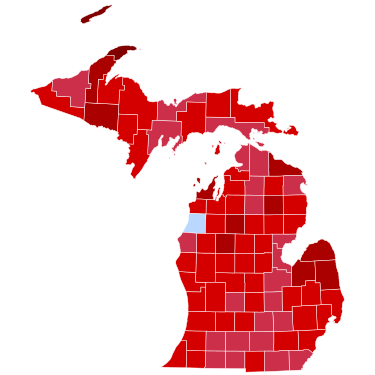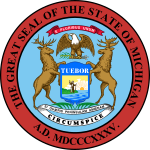| ||||||||||||||||||||||||||
All 15 Michigan votes to the Electoral College | ||||||||||||||||||||||||||
|---|---|---|---|---|---|---|---|---|---|---|---|---|---|---|---|---|---|---|---|---|---|---|---|---|---|---|
| ||||||||||||||||||||||||||
 County Results
| ||||||||||||||||||||||||||
| ||||||||||||||||||||||||||
| Elections in Michigan |
|---|
 |
The 1920 United States presidential election in Michigan took place on November 2, 1920, as part of the 1920 United States presidential election. Voters chose 15[1] representatives, or electors, to the Electoral College, who voted for president and vice president.
Ever since the Panic of 1893 and the Populist movement, Michigan had been rigidly one-party polity dominated by the Republican Party.[2] In the 1894 elections, the Democratic Party lost all but one seat in the Michigan legislature,[3] and over the four ensuing decades the party would never make major gains there.[2]
The dominance of the culture of the Lower Peninsula by anti-slavery Yankees[4] would be augmented by the turn of formerly Democratic-leaning German Catholics away from that party as a result of the remodelled party’s agrarian and free silver sympathies, which became rigidly opposed by both the upper class and workers who followed them,[5] while the Populist movement eliminated Democratic ties with business and commerce of Michigan and other Northern states.[6] Unlike the other states of the Upper Midwest, the Yankee influence on the culture of the Lower Peninsula was so strong that left-wing third parties did not provide significant opposition to the Republicans, nor was there more than a moderate degree of coordinated factionalism within the hegemonic Michigan Republican Party.[7]
Although by taking a substantial proportion of the 1912 “Bull Moose” vote, incumbent president Woodrow Wilson had managed the best performance in Michigan by a Democrat since Grover Cleveland in 1888,[8] 1918 saw a major reaction against Wilson throughout the Midwest, due to supposed preferential treatment of Southern farmers:[9] Republicans would hold every seat in the State Senate for over a decade after the fall election,[10] as they had between 1895 and 1897 and between 1905 and 1911.
During the 1920 election campaign Michigan gained almost no attention because it had been so firmly Republican over the past quarter century. A poll of four university students showed three voting for Republican candidate Warren G. Harding and one for Democratic opponent James M. Cox.[11] A later poll in October showed that the very small August poll was not inaccurate, with Harding leading by slightly less than three-to-one.[12] The Post-Crescent’s expectations were fulfilled, as Harding won in a landslide, with almost 73 percent of the vote to only 22.27 percent for Cox.
- ^ "1920 Election for the Thirty-Fourth Term (1921-1925)". Retrieved April 3, 2018.
- ^ a b Burnham, Walter Dean. "The System of 1896: An Analysis". The Evolution of American Electoral Systems. pp. 178–179. ISBN 0313213798.
- ^ "Swamped! The Democrats Drowned Out by a Tremendous Republican Tidal Wave". The L'Anse Sentinel. L'Anse. November 10, 1894. p. 1.
- ^ English, Gustavus P.; Proceedings of the Ninth Republican National Convention (1888), p. 234
- ^ Sundquist, James. Politics and Policy: The Eisenhower, Kennedy, and Johnson Years. p. 526. ISBN 0815719094.
- ^ Rogowski, Ronald (2020). Commerce and Coalitions: How Trade Affects Domestic Political Alignments. Princeton University Press. ISBN 0691219435.
- ^ Hansen, John Mark; Shigeo, Hirano; Snyder Jr., James M. "Parties within Parties: Parties, Factions, and Coordinated Politics, 1900-1980". In Gerber, Alan S.; Schickler, Eric (eds.). Governing in a Polarized Age: Elections, Parties, and Political Representation in America. pp. 165–168. ISBN 978-1-107-09509-0.
- ^ "Presidential General Election Results Comparison — Michigan". Dave Leip’s U.S. Election Atlas.
- ^ Morello, John A. Albert D. Lasker, Advertising, and the Election of Warren G. Harding. p. 64. ISBN 0275970302.
- ^ Kang, Michael S. (May 29, 2019). "Hyperpartisan Gerrymandering". Boston College Law Review. 69: 1395.
- ^ "Harding Elected By Students of N.Y. University — Practically Every State Is Represented in "Election" Held Recently: Many Women Vote for Him; Cox Runs Second and Debs Polls Nearly as Many as Democrat". The Lima Gazette and The Lima Republican. Lima, Ohio. August 22, 1920. p. 15.
- ^ "Women of Nation Vote for Harding: Rexall Returns Show that They Furnish One-Quarter of Voting Strength". The Post-Crescent. Appleton, Wisconsin. October 8, 1920. p. 8.


